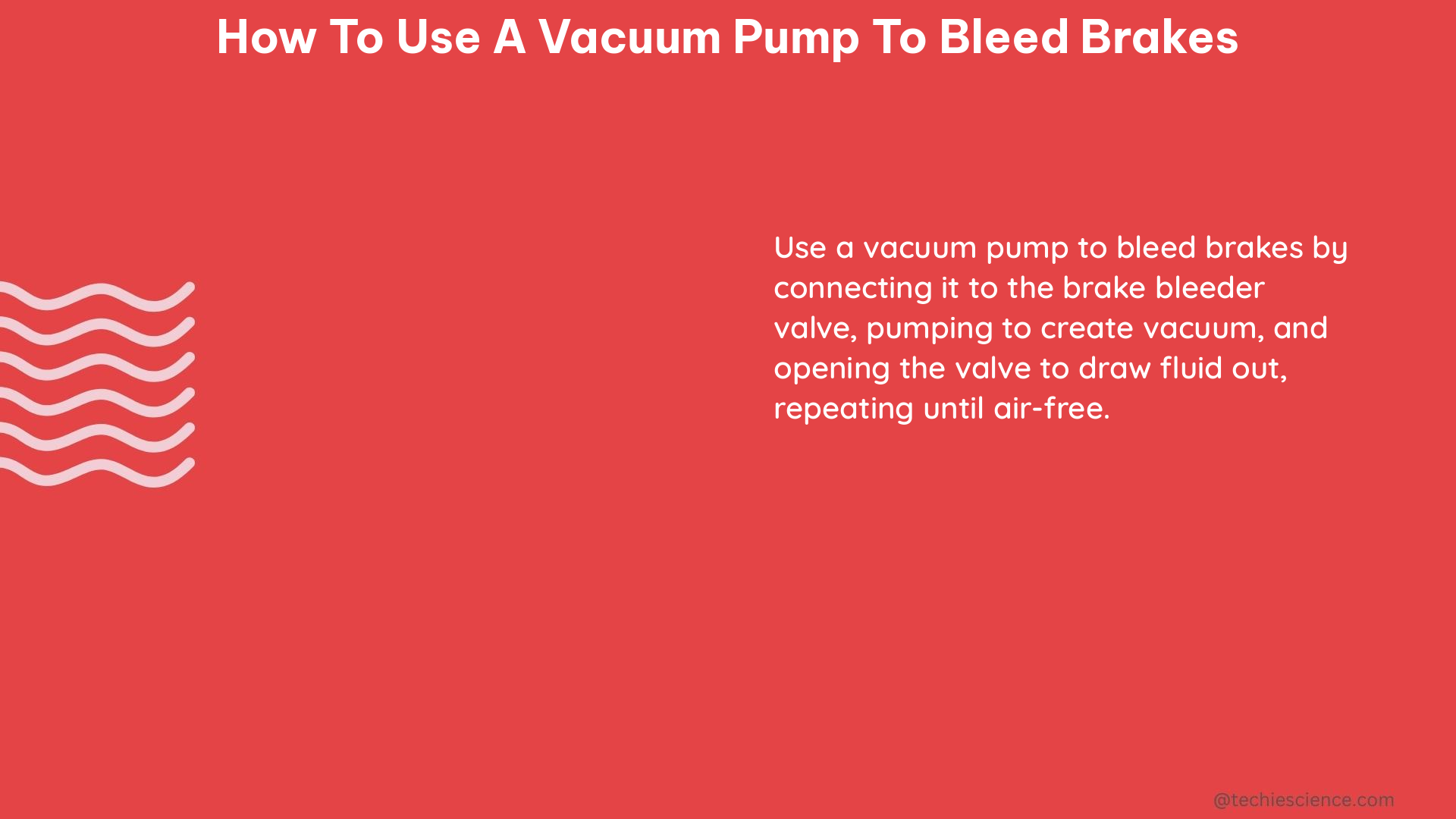Bleeding brakes using a vacuum pump is a highly effective and efficient method to remove air from the brake system, ensuring optimal brake performance and safety. This comprehensive guide will walk you through the step-by-step process of using a vacuum pump to bleed brakes, providing you with the technical details and expert insights to ensure a successful DIY brake bleeding experience.
Necessary Tools and Supplies
Before we dive into the bleeding process, let’s ensure you have all the required tools and supplies:
- Vacuum Pump: The vacuum pump is the heart of the operation, capable of generating the necessary suction to draw out air bubbles from the brake lines. Look for a high-quality vacuum pump with a minimum of 20 in-Hg (inches of mercury) of vacuum pressure.
- Socket and Ratchet: You’ll need a socket and ratchet set to access the brake caliper bleeder screws, typically ranging from 8mm to 14mm in size.
- Wrench: A set of open-end or combination wrenches will be handy for loosening and tightening the bleeder screws.
- Rags: Absorbent rags are essential for containing and cleaning up any spilled brake fluid.
- Rubber Gloves: Protect your hands from the corrosive effects of brake fluid by wearing a pair of rubber gloves.
- Brake Fluid: Ensure you have the correct type and quantity of brake fluid for your vehicle, as specified in the owner’s manual.
- Brake Cleaner: A can of brake cleaner can be useful for cleaning up any spills or drips during the bleeding process.
Preparing the Vehicle and Brake System

- Lift the Vehicle: Position the vehicle on a level surface and use a floor jack to lift it, ensuring it is securely supported by jack stands.
- Remove the Wheels: Take off the wheels to gain access to the brake calipers and bleeder screws.
- Locate the Bleeder Ports: Identify the bleeder ports on each brake caliper, typically located at the top or side of the caliper. Remove the dust caps or sleeves to expose the bleeder screws.
Assembling the Vacuum Bleeder Kit
- Connect the Vacuum Hose: Attach the vacuum hose to the vacuum pump, ensuring a secure and airtight connection.
- Attach the Catch Canister: Connect the vacuum hose to a catch canister, which will collect the old brake fluid and air bubbles during the bleeding process.
- Secure the Vacuum Pump: Position the vacuum pump in a stable and accessible location, ensuring it is within reach of the bleeder screws.
Bleeding the Brakes
- Start with the Wheel Furthest from the Master Cylinder: Begin the bleeding process with the wheel farthest from the master cylinder, typically the right rear wheel.
- Connect the Vacuum Hose to the Bleeder Port: Attach the vacuum hose to the bleeder port on the brake caliper, ensuring a tight seal to maintain the vacuum.
- Drain and Replace Brake Fluid: Locate the brake fluid reservoir and remove the old fluid. Refill the reservoir with new, clean brake fluid, keeping the cap loose to allow airflow.
- Activate the Vacuum Pump: Turn on the vacuum pump and monitor the vacuum gauge. Maintain a vacuum of at least 10 in-Hg (inches of mercury) during the bleeding process.
- Open the Bleeder Screw: Slowly open the bleeder screw on the brake caliper, allowing the vacuum to draw the old fluid and air bubbles out of the system. Keep the screw open until the fluid flowing into the catch canister is free of air bubbles.
- Close the Bleeder Screw: Once the fluid is clear of air bubbles, close the bleeder screw and move on to the next wheel, repeating the process until all four wheels have been bled.
- Bleed the Master Cylinder: After bleeding the individual wheels, you may need to bleed the master cylinder to ensure the entire brake system is free of air. Consult your vehicle’s service manual for the proper procedure.
Finalizing the Brake Bleeding Process
- Check Brake Fluid Level: Ensure the brake fluid reservoir is filled to the proper level, as specified in the owner’s manual.
- Test the Brakes: Start the engine and pump the brake pedal several times to check the brake system’s responsiveness. The pedal should feel firm and the brakes should operate effectively.
- Inspect for Leaks: Carefully inspect the entire brake system for any signs of fluid leaks, paying close attention to the bleeder screws and connections.
- Reinstall the Wheels: Once you’re satisfied with the brake system’s performance, reinstall the wheels and lower the vehicle to the ground.
Remember, brake fluid can be corrosive and damaging to paint, so take precautions to avoid spills and clean up any drips immediately. Additionally, ensure you dispose of the old brake fluid properly, as it is considered a hazardous material.
By following this comprehensive guide, you’ll be able to effectively use a vacuum pump to bleed your vehicle’s brakes, ensuring optimal brake performance and safety. If you encounter any issues or have additional questions, refer to the following resources for further guidance:
References:
- DIY: How to Bleed Brakes Using a Vacuum Pump – YouTube
- How To Bleed Brake Fluid With a Pneumatic Vacuum Pump – The Drive
- How do I properly bleed the brakes with a hand-held vacuum pump? – AudiWorld

The lambdageeks.com Core SME Team is a group of experienced subject matter experts from diverse scientific and technical fields including Physics, Chemistry, Technology,Electronics & Electrical Engineering, Automotive, Mechanical Engineering. Our team collaborates to create high-quality, well-researched articles on a wide range of science and technology topics for the lambdageeks.com website.
All Our Senior SME are having more than 7 Years of experience in the respective fields . They are either Working Industry Professionals or assocaited With different Universities. Refer Our Authors Page to get to know About our Core SMEs.